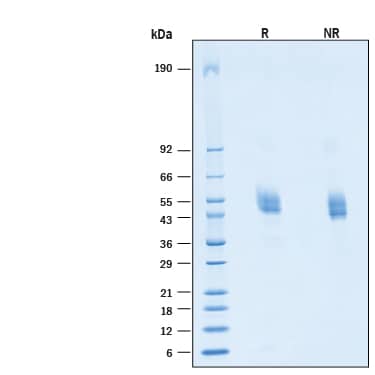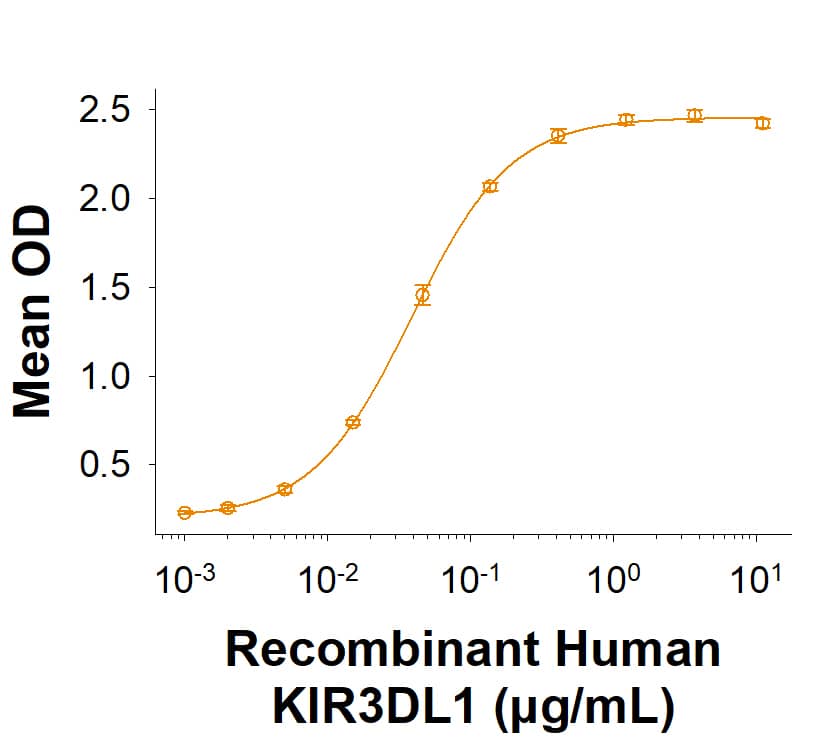Recombinant Human KIR3DL1 His-tag Protein, CF
R&D Systems, part of Bio-Techne | Catalog # 11101-KR

Key Product Details
Product Specifications
Source
His22-His340, with C-terminal 6-His tag
Purity
Endotoxin Level
N-terminal Sequence Analysis
Predicted Molecular Mass
SDS-PAGE
Activity
Scientific Data Images for Recombinant Human KIR3DL1 His-tag Protein, CF
Recombinant Human KIR3DL1 His-tag Protein Binding Activity.
Measured by its ability to bind HLA on MDA‑MB‑231 human breast cancer cells. The ED50 for this effect is 0.0200-0.200 μg/mL.Recombinant Human KIR3DL1 His-tag Protein SDS-PAGE.
2 μg/lane of Recombinant Human KIR3DL1 His-tag Protein (Catalog # 11101-KR) was resolved with SDS-PAGE under reducing (R) and non-reducing (NR) conditions and visualized by Coomassie® Blue staining, showing bands at 45-58 kDa.Formulation, Preparation and Storage
11101-KR
| Formulation | Lyophilized from a 0.2 μm filtered solution in PBS with Trehalose. |
| Reconstitution | Reconstitute at 100 μg/mL in PBS. |
| Shipping | The product is shipped at ambient temperature. Upon receipt, store it immediately at the temperature recommended below. |
| Stability & Storage | Use a manual defrost freezer and avoid repeated freeze-thaw cycles.
|
Background: KIR3DL1
KIR3DL1 (3DL1, previously called NKB1 or NKAT3, designated CD158e) is a 70 kDa type I transmembrane glycoprotein that belongs to the killer cell Ig-like receptor (KIR) family. KIRs are expressed on CD56dim NK cells and T cell subsets where they regulate effector functions in the innate immune system (1 - 3). KIRs are named for the number of Ig-like domains (2D or 3D) in the extracellular domain (ECD), and whether they have long or short (L, S) cytoplasmic tails. Like other inhibiting KIRs, KIR3DL1 has two ITIM domains within its long tail (2). The 319 amino acid (aa) ECD of KIR3DL1 shows 97% aa identity with an activating KIR, KIR3DS1, and the two segregate as alleles (3, 4). KIR3DL1 binds to HLA antigens. This includes HLA-A and -B molecules. Among the HLA-B variants, only the Bw4 epitope, which is present within only one third of all HLA-B alleles, is recognized by KIR3DL1 (4). An NK cell expressing KIR3DL1 is prevented from killing a cell expressing the Bw4 epitope on its surface. However, if the epitope is downregulated on the cell surface due to viral infection, the NK cell is released from inhibition and now kills the infected cell. KIR genes are highly polymorphic, and specific KIR3DL1 alleles vary in surface expression and activity. For example, the allele KIR3DL1*004 is associated with slow progression to AIDS in HIV infected individuals that also express Bw4 (6). Unlike most alleles that are surface-expressed, this allele is mainly retained within the cell (7). KIR3DL1/S1 is the only KIR receptor to have an ortholog in non-primates, including selected mouse strains in which it is also called KIRL1 (KIR-like 1). Although the ECD of human KIR3DL1 shares 40 - 48% aa identity with mouse, rat and bovine KIR3DL1, the transmembrane and cytoplasmic regions in the non-primate species show no obvious activating or inhibiting motifs (8, 9).
References
- Colonna, M. and J. Samaridis (1995) Science 268:405.
- Lanier, L. L. (2005) Annu. Rev. Immunol. 23:225.
- Uhrberg, M. et al. (1997) Immunity 7:753.
- O’Connor, G. M. et al. (2007) J. Immunol. 178:235.
- Thananchai, H. et al. (2007) J. Immunol. 178:33.
- Martin, M.P. et al. (2007) Nat. Genet. 39:733.
- Pando, M.J. et al. (2003) J. Immunol. 171:6640.
- Hoelsbrekken, S.E. et al. (2003) J. Immunol. 170:2259.
- Wilson, E.B. et al. (2007) Immunogenetics 59:641.
Long Name
Alternate Names
Gene Symbol
UniProt
Additional KIR3DL1 Products
Product Documents for Recombinant Human KIR3DL1 His-tag Protein, CF
Product Specific Notices for Recombinant Human KIR3DL1 His-tag Protein, CF
For research use only

